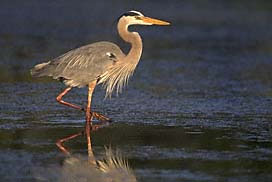 The Nanticoke River is one of the largest rivers on the Delmarva Peninsula, supported by a watershed that is nearly 530,000 acres in size, and draining into the Chesapeake Bay. In 1993, the Nature Conservancy, the Conservation Fund and the National Fish and Wildlife Foundation assisted the Maryland Department of Natural Resources in purchasing the 1,587 acre Nutter’s Neck tract (Wic. Co.). With this purchase, the Nanticoke River WMA was established to help conserve the wildlife habitats found along this mostly tidal river, and to provide outdoor recreational opportunities for the public to be able to enjoy. Over time additional tracts have been added to the WMA which include: Calloway Wharf (Dor. Co.) 55 acres, Lower Marshyhope Swamp (Dor. Co.) 415 acres, and Sharptown Dunes (Wic. Co.) 198 acres
The Nanticoke River is one of the largest rivers on the Delmarva Peninsula, supported by a watershed that is nearly 530,000 acres in size, and draining into the Chesapeake Bay. In 1993, the Nature Conservancy, the Conservation Fund and the National Fish and Wildlife Foundation assisted the Maryland Department of Natural Resources in purchasing the 1,587 acre Nutter’s Neck tract (Wic. Co.). With this purchase, the Nanticoke River WMA was established to help conserve the wildlife habitats found along this mostly tidal river, and to provide outdoor recreational opportunities for the public to be able to enjoy. Over time additional tracts have been added to the WMA which include: Calloway Wharf (Dor. Co.) 55 acres, Lower Marshyhope Swamp (Dor. Co.) 415 acres, and Sharptown Dunes (Wic. Co.) 198 acres
What to see
Visitors to Nanticoke River WMA might glimpse one of the many bald eagles that frequent the river in search of food. Any trip along the bottomland forests could yield abundant opportunities to see a number of wading birds and waterfowl, as the marshes are extremely productive and support a wide variety of birds. Wild turkeys have long been established in the area, and Sika deer continue to expand into habitats surrounding the stream corridors in the watershed.
 What to do
What to do
Upland areas and wetlands provide opportunities for deer hunters to pursue white-tail deer and a few sika deer found here. Fields and woodland edges provide habitat for mourning doves, cottontail rabbits, bobwhite quail, and woodcock. The wetlands, rivers, and creeks offer opportunities for waterfowl hunting. Trapping is offered by yearly lease. Anglers will find bass, catfish, rockfish and perch and may fish along the shoreline or from a boat. Boat access is available via public ramps at Wetipquin, Sharptown, Federalsburg and Vienna. A peninsula jutting from Nutter’s Neck into the wetlands and the Nanticoke River offers a scenic hike which may include bird watching and nature photography.
Area Regulations
-
Use of Nanticoke River WMA is generally permitted seven days a week throughout the year.
- Hunting is allowed in accordance with open seasons and shooting hours, unless otherwise noted.
- All State and Federal Hunting Laws and Regulations are applicable.
- Trapping is by permit only.
- Dove hunting is restricted to certain days and shooting hours.
- No motorized vehicles are allowed.
Special Areas
- Certain fields are managed dove hunting areas and have additional hunting restrictions.
Non-hunting Users Guide
- The Nanticoke River WMA provides habitat for an abundance of local and migratory wildlife species including birds, mammals, insects, reptiles and amphibians.
- Non-hunting visitors are welcome.
- The Nanticoke River WMA provides a unique opportunity to explore an Atlantic white cedar swamp, if you visit in your small boat, kayak, or canoe.
- Some upland trails are maintained and suitable for hiking, nature photography, birding, hunting and other recreational activities, but are not actively marked.
- Be aware of open hunting seasons and visit accordingly.
- Hunting season dates are available in newspapers, on the Internet, and at some area stores.
- Visitors to the management area should be aware that there are likely to be biting flies, mosquitoes, and ticks present during most of the year.
Site Management Goals
- Support active management strategies to improve habitats and strengthen wildlife populations:
- Leave winter food crops standing for upland wildlife species;
- Provide managed dove field hunting opportunities;
- Riparian areas have been planted with trees and native grasses to provide upland wildlife habitat and protect water quality;
- Preserve the pristine nature of the natural resources contained within the parcels which comprise the WMA.
- Protect and enhance rare habitats.
 Directions
Directions
Nutter’s Neck: From US Route 50,
take either MD 347 or MD 349 to Quantico, MD. Go west on Cherry Walk
road to Nutter's Neck Road and left to designated parking areas. Boat
access is via Vienna and Wetipquin public boat ramps.
Lower Marshyhope Swamp: Access is by boat only via Sharptown or Federalsburg public boat ramps.
Sharptown Dunes: From US Route 50, take MD 313
north towards Sharptown designated parking area on left ½ mile before
Sharptown. Boat access is via Sharptown public boat ramp.
Calloway Wharf: Access is by boat only via Sharptown public boat ramp.
For additional information contact the LeCompte Work Center at 410-376-3236.
 Click Here for Map (Nutter's Neck)
Click Here for Map (Nutter's Neck)
 Click Here for Map (Lower Marshyhope Swamp)
Click Here for Map (Lower Marshyhope Swamp)
 Click Here for Map (Calloway Wharf and Sharptown Dunes)
Click Here for Map (Calloway Wharf and Sharptown Dunes)